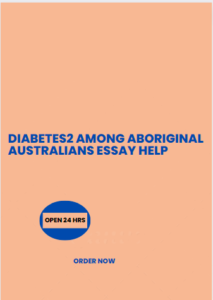Diabetes2 Among Aboriginal Australians
Diabetes2 is a serious condition that affects many different people across the world. However, some populations of people suffer from it at a much higher rate than others. One such population is the Aboriginal Australians. The condition is not dependent on insulin and is very common in this particular group. At nursingresearchhelp.com we help Australian students to write well reading, organised and quality papers on Diabetes2 Among Aboriginal Australians

IFG
Indigenous Australians are more at risk of developing type 2 diabetes than non-indigenous populations. This has implications for the prevention and management of the disease.
Several studies have been conducted on the topic. For instance, Wang et al compared the incidence of diabetes in an indigenous population over 13 years. They found that approximately 18 per 1000 person years were diagnosed with the disease. Similarly, a cohort study in the Indian subcontinent reported an incidence of 20.2 per 1000 person years.
A more recent study involving Western Australian women examined the incidence of gestational diabetes. It found that the rate of pre-gestational diabetes increased from 6.7 to 11.5% in Aboriginal women, although the figure remained below 1% for non-Aboriginal women.
The study found that the presence of IFG alone was associated with a doubled risk of diabetes. In addition, the presence of IGT alone was also associated with a doubling of the risk of diabetes.
The study also found that the prevalence of IFG was not related to the admission rate for IFG, nor to the rate of normoglycaemia. However, the overall rate of admission was significantly higher for participants with diabetes, as opposed to normoglycaemia. Likewise, the rate of hospitalisation was twice as high for participants with diabetes as it was for those with normoglycaemia.
As for the significance of the findings, the authors were careful to point out that their study is an exploratory one. Further research is necessary to understand the underlying factors that drive these trends. Also, the study did not offer any financial rewards for participating.
Nonetheless, the outcomes of the study add to the limited existing evidence on temporal trends in the DIP burden in Aboriginal populations. Therefore, it is important that appropriate primary prevention strategies are implemented to combat the high lifetime risk of developing diabetes in Aboriginal people.
IGT
The prevalence of impaired glucose tolerance (IGT) and diabetes among Aboriginal Australians is quite high. Studies show that IGT alone doubles the risk of developing diabetes. In addition, people with pre-diabetes have a higher incidence of type 2 diabetes. Therefore, people who are at high risk should be screened.
There are various social factors that influence the development of diabetes. One factor is material deprivation. This directly affects the ability to manage diabetes. Also, living conditions that are chaotic can also undermine the capacity to handle stress. These factors should be incorporated into diabetes management with Indigenous people.
Another factor that contributes to the high risk of developing diabetes is obesity. People with abdominal fat are at increased risk of developing insulin resistance. Additionally, increased levels of physical activity can reduce weight. Moreover, a decentralized lifestyle may protect against glucose intolerance.
Preventive strategies that involve healthy lifestyle changes such as eating more fruits and vegetables and taking more exercise may help to reduce the risk of developing diabetes. However, these strategies should be implemented in collaboration with health care providers, community leaders, and funding agencies.
As such, health care providers need to be able to appropriately elicit cultural practices from Indigenous peoples. They should also use current clinical practice guidelines to manage the condition.
Furthermore, the social and cultural contexts of the community should be incorporated into the diabetes care process. A study involving Algonquin women explored how cultural practices could facilitate the prevention of diabetes. It found that a better diet and educational resources could save money and preserve cultural values.
An 11-year study of over 600 Aboriginal Australians showed that the presence of IGT alone was associated with a doubling of the risk of developing diabetes. Nevertheless, researchers caution that their findings cannot be generalized to all indigenous populations.
Strongyloides
Strongyloides and diabetes among Aboriginal Australians have been reported to have a relationship, albeit in a minority of cases. It is not known whether the association is causal, but it may be a result of a link between the chronic helminth infection and metabolic disorders.
There are many factors that contribute to the high rates of Strongyloides infection. Housing, social practices and environmental conditions are some of the most common causes. These factors can lead to a failure to diagnose Strongyloides, which in turn can have disastrous consequences.
The prevalence of Strongyloides stercoralis is higher in remote Aboriginal communities. This reflects the persistent social disadvantage experienced by some Aboriginal communities. Some communities have developed strategies to protect themselves against the disease, while others have not. However, despite these efforts, some communities have been found to have higher prevalences than other parts of Australia.
A study conducted in central Australia explored the associations between Strongyloides stercoralis and metabolic diseases. HTLV-1, the causative agent of Strongyloides, was identified as a possible risk factor for diabetes. In a multivariate model, decreasing age, body mass index and HTLV-1 PVL were significant risk factors.
Another retrospective cohort study reported higher admission rates for Strongyloides patients, compared with those without. Similarly, a case-control study conducted in Ethiopia indicated that a higher prevalence of Strongyloides was associated with anemia.
In northern Australia, a Strongyloides seroprevalence study indicated that the overall prevalence of the disease exceeded twenty percent in some Aboriginal adults. This is higher than the rate in non-disadvantaged communities, which was about 2%.
While the relationship between Strongyloides and diabetes is not clear, it has been reported that a lower prevalence of diabetes was seen in the community clinic setting. However, the effectiveness of the treatment was dependent on the method used for the diagnosis.
Diagnosis
Diabetes prevalence among Aboriginal and Torres Strait Islander people has been increasing in recent years. These individuals often have other chronic conditions and are at risk of complications. Having diabetes increases the risk of kidney disease, which may affect a person’s ability to function. Approximately half of Aboriginal and Torres Strait Islander individuals with diabetes have signs of chronic kidney disease.
A study of the prevalence of diabetes and associated comorbidities among Aboriginal and Torres Strait Islander adults in the Northern Territory of Australia was conducted. It sought to clarify patterns of determinants of diabetes and to identify associations with baseline variables.
Data were collected in a retrospective cohort analysis of clinical and administrative data. Twenty-two thousand seven hundred and seventy-seven Aboriginal people were surveyed. The prevalence of diabetes was 14.4% in the 2012-2013 financial year. This rate was comparable to the non-Indigenous population rate of 15.0%.
Diabetes prevalence in remote Indigenous communities was higher than that found in non-remote areas. One in five Aboriginal people living in remote communities had diabetes, compared with one in ten in non-remote regions.
Age is a major risk factor for the development of diabetes. Almost one in five adults aged 35-44 have diabetes, compared with 3% in the general Australian population. Another factor contributing to the prevalence of diabetes is pregnancy. Among Aboriginal women, pre-gestational diabetes is a common condition. Despite numerous improvements in antenatal care, the prevalence of gestational diabetes has increased.
Aboriginal people with type 2 diabetes are at a greater risk of cardiovascular complications and metabolic complications. Among young Indigenous people, the rate of hypertension is greater than that of younger non-Indigenous adults. They also have a higher incidence of dyslipidaemia and obesity.
Treatment
A growing burden of type 2 diabetes is being experienced by Aboriginal people in remote communities. These young individuals have higher rates of comorbidities and complications. As a result, more attention must be given to ensuring that they receive adequate education and support.
The incidence of diabetes in Indigenous Australians has increased over the past decade. Despite high incidence rates, these individuals have lower treatment outcomes. Some of these factors include social and economic disadvantage. For example, the risk of obesity is significantly higher among Indigenous women. This contributes to a greater disparity in life expectancy.
In the current study, we examined the prevalence and costs of primary care for Indigenous Australians with diabetes in remote Northern Territory (NT) communities. The NT Government Primary Care Information System was used for this analysis. Using this system, we assessed the prevalence of diabetes in 21 267 Aboriginal people from 51 remote NT communities. Our findings indicate that the incidence rate of diabetes in these communities was 17.0%.
The prevalence of diabetes in these communities is higher than the national rate. The higher prevalence observed is consistent with the global trend of increased prevalence of type 2 diabetes.
Type 2 diabetes is a significant disease of poverty. Nevertheless, the disease is also preventable and treatable. To prevent the onset of type 2 diabetes, healthy lifestyle choices should be adopted. Increased physical activity and reduced sedentary behaviour can delay its onset. It is important to educate these communities about the risks of diabetes and how to take control.
Aboriginal and Torres Strait Islander people have a higher prevalence of diabetes than non-Indigenous Australians. This is particularly true in remote communities. However, there is evidence that improved socioeconomic conditions may reduce the overall burden of the disease.

